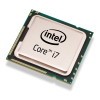- Qualcomm Launches Snapdragon 4 Gen 2 Mobile Platform
- AMD Launches Ryzen PRO 7000 Series Mobile & Desktop Platform
- Intel Launches Sleek Single-Slot Arc Pro A60 Workstation Graphics Card
- NVIDIA Announces Latest Ada Lovelace Additions: GeForce RTX 4060 Ti & RTX 4060
- Maxon Redshift With AMD Radeon GPU Rendering Support Now Available
Intel Core i7-975 Extreme Edition

It’s been a good seven months since the launch of the original Core i7 processors, so isn’t it about time we got to see some new models? Don’t fret, as Intel has just announced their i7-950 3.06GHz mid-range and i7-975 3.33GHz high-end models. We’re taking a look at the latter today, so let’s see how it compares to its predecessor.
Page 8 – System: Sandra Memory, Multi-Core Efficiency
Generally speaking, the faster the processor, the higher the system-wide bandwidth and the lower the latency. As is always the case, faster is better when it comes to processors, as we’ll see below. But with Core i7, the game changes up a bit.
Whereas previous memory controllers utilized a dual-channel operation, Intel threw that out the window to introduce triple-channel, which we talked a lot about at August’s IDF. Further, since Intel integrates the IMC onto the die of the new CPUs, benefits are going to be seen all-around.
Before jumping into the results, we already had an idea of what to expect, and just as we did, the results seen are nothing short of staggering.


As far as I’m concerned, benchmarking for memory bandwidth is almost a moot point, because at some point, we hit a wall when the real-world benefits will stop being increased. In the case of AMD, their integrated memory controller avails us more than enough bandwidth, out-performing Intel’s entire Core 2 line-up with absolute ease. It falls a bit short of Intel’s triple-channel configuration, but that was to be expected. Again though, anything over 5,000MB/s is very unlikely to benefit a regular consumer.
The latency though, is far more important. The faster the instructions can get sent from the processor to the memory, and vice versa, the better. For the most part, no CPU here is truly lacking, except maybe the E5200 and X2 7750, as they have very high latencies. The rest of the results are fairly equal latency-wise across all Intel and AMD CPUs.
Sandra 2009 Multi-Core Efficiency
How fast can one core swap data with another? It might not seem that important, but it definitely is if you are dealing with a true multi-threaded application. The faster data can be swapped around, the faster it’s going to be finished, so overall, inter-core speeds are important in every regard.
Even without looking at the data, we know that Core i7 is going to excel here, for a few different reasons. The main is the fact that this is Intel’s first native Quad-Core. Rather than have two Dual-Core dies placed beside each other, i7 was built to place four cores together, so that in itself improves things. Past that, the ultra-fast QPI bus likely also has something to do with speed increases.

This test is where we can see huge differences between AMD’s and Intel’s CPUs, with Intel being the clear leader in both inter-core bandwidth and latencies. How much this matters in the grand scheme, but seeing as AMD’s offerings scale quite well in multi-threaded benchmarks, I’m assuming it’s not much. Still, it’s rather interesting to see such staggering differences between the architectures here.
Support our efforts! With ad revenue at an all-time low for written websites, we're relying more than ever on reader support to help us continue putting so much effort into this type of content. You can support us by becoming a Patron, or by using our Amazon shopping affiliate links listed through our articles. Thanks for your support!





